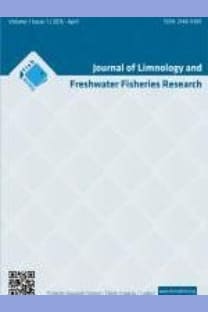Chlorella vulgaris Beyerinck [Beijerinck] (Chlorophyta) Suşlarının Kesikli Kültür Sisteminde Yığın Kültürlerinin Üretimi Üzerine Bir Çalışma
A Study on the Production of Batch Cultures in Semi-Continuous Culture System of Chlorella vulgaris Beyerinck [Beijerinck] (Chlorophyta) Strains
___
- Aguoru CU, Okibe PO. 2015. Content and composition of lipid produced by Chlorella vulgaris for biodiesel production. Advances in Life Science and Tech. 36 (2015):96-100.
- Al-lwayzy SH, Yusaf T, Al-Juboori RA. 2014. Biofuels from the Fresh Water Microalgae Chlorella vulgaris (FWM-CV) for Diesel Engines. Energies 7(3):1829-1851.
- doi:10.3390/en7031829 Amini KZ, Seyfabadi J, Ramezonpour Z. 2012. Effect of light intensity and photoperiod on bimass and fatty acid composition of the microalgae, Chlorella vulgaris. Aquacult. Int. 20(1):41-49.
- doi: 10.1007/s10499-011-9440-1 Andersen RA. 2005. Algal culturing techniques. Burlington: Elsevier Academic Press 578 p.
- Baydar S. 1990. Tohumsuz bitkiler sistematiği. Trabzon: Karadeniz Teknik Üniversitesi 261 s.
- Becker EW. 1994. Microalgae: biotechnology and microbiology. New York: Cambridge University Press 293 p.
- Behrens PW. 2005. Photobioreactors and fermentors: the light and dark sides of growing algae. In: Andersen RA, editors. Algal culturing techniques, London: Elsevier Academic Press. p. 189-204.
- Benli HA, Uçal O. 1990. Deniz canlı kaynakları yetiştirme teknikleri. Bodrum: T.C. Tarım, Orman ve Köy İşleri Bakanlığı, Su Ürünleri Araştırma Ens. Müd. Seri A. Yayın no:3 105 s.
- Borcaklı M. 1987. Yeni gıda kaynağı olarak mikroalgler ve üretim yöntemleri. Kocaeli: TÜBİTAK MAM Beslenme ve Gıda Teknolojileri ile Soğutma Tekniği Araştırma Bölümü. Cilt 2. Yayın no:12. 73-86.
- Borowitzka MA, Borowitzka JL. 1988. Micro-algal biotechnology. Cambridge: Cambridge University Press.
- Brennan L, Owende P. 2009. Biofuels from microalgae - A review of technologies for production, processing and extractions of biofuels and co-products. Renewable and Sustainable Energy Reviews 14(2):557-577. doi:10.1016/j.rser.2009.10.009
- Chia MA, Lombardi AT, Melao MDG. 2013. Growth and biochemical composition of Chlorella vulgaris in different growth media. An Acad Bras Cienc. 85(4):1427-1438. doi: 10.1590/0001-3765201393312
- Chu WL, See TC, Phang SM. 2009. Use of immobilised Chlorella vulgaris for the removal of colour from textile dyes. J Appl Phycol. 21(6): 641-648. doi: 10.1007/s10811-008-9396-3
- Cirik S, Gökpınar Ş. 1993. Plankton Bilgisi ve Kültürü. İzmir: Ege Üniversitesi Basımevi 274 s. Cohen Z. 1999. Chemical from Microalgae. London: Taylor&Francis UK 419 p.
- CSIRO 2016. Commonwealth Scientific and Industrial Research Organisation. Microalgal Isolation Techniques; [Erişim Tarihi: 29.11.2016]. Erişim Adresi:http://www.marine.csiro.au/microalgae/ methods/microalgal%20isolation%20techniques.htm
- Feng P, Deng L, Hu F. 2012. Lipid accumulation and growth characteristics of Chlorella zofingiensis under different nitrate and phosphate concentrations. J Biosci Bioeng. 114(4):405-410. doi: 10.1016/j.jbiosc.2012.05.007
- Guillard RRL, Sierachiki MS. 2005. Counting cells in cultures with the light microscope. In: Andersen RA, editors. Algal culturing techniques, London: Elsevier Academic Press. p. 239-252.
- Hakalin NLS, Paz AP, Aranda DAG, Moraes LMP. 2014. Enhancement of cell growth and lipid content of a freshwater microalga Scenedesmus sp. by optimizing nitrogen, phosphorus and vitamin concentrations for biodiesel production, Natural Science. 6(12):1044-1054. doi: 10.4236/ns.2014.612095
- Hamedi S, Mahdavi MA, Gheshlaghi R. 2016. Improved lipid and biomass productivities in Chlorella vulgaris by differing inoculation medium from production medium. Biofuel Research Journal 10(2016):410-416. doi: 10.18331/BRJ2016.3.2.6
- Hosikian A, Lim S, Halim R, Danquah KM. 2010. Chlorophyll extraction form microalgae: A review on the process engineering aspects. International Journal of Chemical Engin. 2010:1-11. doi: 10.1155/2010/391632
- Iwamoto H. 2004. Industrial production of microalgal cellmass and secondary products-major industrial species Chlorella. In: Richmond A, editors. Handbook of microalgal culture: biotechnology and applied phycology. UK: Blackwell Science 255-263.
- Kumar K, Das D. 2012. Growth characteristics of Chlorella sorokiniana in airlift and bubble column photo-bioreactors. Bioresour Technol. 116:307-313. doi: 10.1016/j.biortech.2012.03.074
- Murdock JN, Wetzel DL. 2009. FT-IR Microspectroscopy enhances biological and ecological analysis of algae. Appl. Spectros. 44(4):335-361. doi: 10.1080/05704920902907440
- Parvin M, Zannat MN, Habib MAB. 2007. Two important technique for isolation of microalgae. Asian Fisheries Science. 20(1):117-124.
- Prescott GW. 1968. The algae. Boston: Michigan State University p. 37-67.
- Prescott GW. 1973. Algae of the Western Great Lakes Area. Michigan: Michigan State University Department of Botany and Plant Pathology 1004 p. Rasmussen RS, Morrissey T, Steve LT. 2007.
- ingredients. Advances in Food and Nutrition Res. 52 (2007):237-292. doi: 10.1016/S1043-4526(06)52005-4 Richmond A. 2004. Handbook of microalgal culture: biotechnology and applied phycology. 2nd ed. Australia: Blackwell Science Ltd. 719 p.
- Ruiz-Marin A, Mendoza-Espinosa L, Stephenson T. 2010. Growth and nutrient removal in free and immobilized green algae in batch and semi-continuous cultures treating real wastewater. Bioresource Techno. 101(1): 58-64. doi: 10.1016/j.biortech.2009.02.076
- Santhosh S, Dhandapani R, Hemalatha NA. 2016. A Review on potential biotechnological applications of microalgae. J App Pharm Sci. 6(08): 179-184. doi: 10.7324/JAPS.2016.60829
- Schenk PM, Thomas-Hall SR, Stephens E, Marx UC, Mussgnug JH, Posten C, Kruse O, Hankamer B. 2008. Second generation biofuels: high-efficiency microalgae for biodisel production. BioEnergy Res. 1(1):20-43.
- doi: 10.1007/s12155-008-9008-8 Shihira I. 1965. Chlorella physiology and taxonomy of forty-one isolates. Maryland: University of Maryland, College Park 97 p.
- Vaiciulyte S, Padovani, G, Kostkeviciene J, Carlozzi P. 2014. Batch growth of Chlorella vulgaris CCALA 896 versus semi-continuous regimen for enhancing oil-rich biomass productivitiy. Energies 7(6):3840-3857. doi:10.3390/en7063840
- ISSN: 2148-9300
- Yayın Aralığı: 3
- Başlangıç: 2015
- Yayıncı: Su Ürünleri Araştırma Enstitüsü Müdürlüğü
Eber Gölü'nün Balık Komunite Yapısı Açısından Güncel Durumu
FATİH MANGIT, Mustafa KORKMAZ, Uğur SÜ, SEDAT VAHDET YERLİ
Su Ürünlerinde Marinat Teknolojisi ve Marinasyonun Kalite Özelliklerine Etkisi
Gönen Çayı (Balıkesir - Türkiye) Durgun Sularının Zooplankton Faunası ve Mevsimsel Değişimleri
Nilay GÜRLEYEN, M. Ruşen USTAOĞLU
Soner ÇETİNKAYA, ŞENGÜL BİLGİN, Ömer Osman ERTAN
Length-Weight Relationships for an Endemic Species Aphanius transgrediens
Hasan M. SARI, IRMAK KURTUL, Ersin AYDIN, ALİ İLHAN
Nasrin NIKMEHR, Soheil EAGDERI, Pariya JALILI
SEMRA SAYGIN, MELEK ÖZPİÇAK, MAHMUT ELP, Nazmi POLAT, ATAMAN ALTUĞ ATICI, Neşe AKÇANAL ÖDÜN
